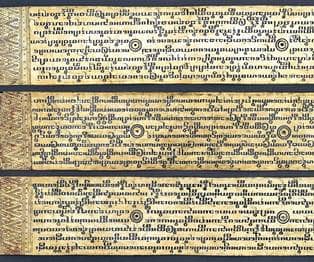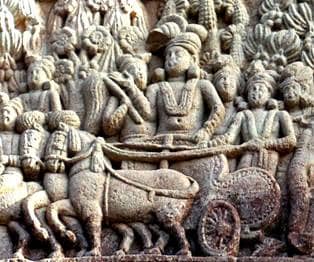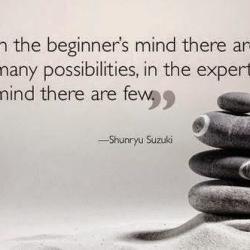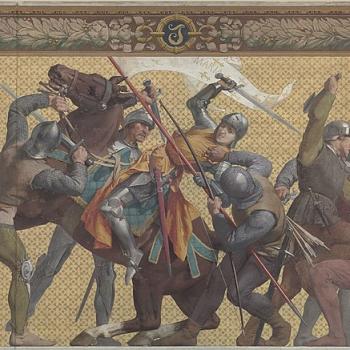- Trending:
- Forgiveness
- |
- Resurrection
- |
- Joy
- |
- Afterlife
Buddhism History
Early Developments
Buddhism arose at a time of significant social and political change. In the regions where it grew and flourished, urban centers were growing rapidly and creating new social conditions. Buddhism — with its egalitarian ideals, its structures for organizing community, and its opportunities for social and religious mobility — was well-suited for the time. With increased trade came a growth in the number of merchants and traders who, even when wealthy and successful, had low social status. Buddhism was appealing because monks were treated equally regardless of their caste. Early texts say that fifty-five of the first sixty of the Buddha's followers were from wealthy and powerful merchant families. Not all monks were wealthy, however; people of any status were welcome.
Regardless of class or economic status, monks had to follow strict rules. A monk could be banished for engaging in sexual relations, stealing, killing someone, or claiming to have supernatural powers. Lesser offenses would lead to a period of probation, the forfeiture of certain privileges, and temporary loss of standing in the community. Monks took vows not to drink alcohol, not to eat after noon, not to indulge in public entertainments, not to use ointments, perfumes, or a comfortable seat or bed, and not to handle money. There were rules against flirting, touching, and masturbation; thirty specific rules about possessions — how one was allowed to acquire and use them; and ninety-two rules that covered miscellaneous offenses such as gossiping or hoarding food. Eventually, all of these rules were recorded in a massive collection of texts, the Vinaya.
When a monk broke a rule, he was required to confess to an assembly of monks, who would then determine and enforce punishment. The assembly would also rule as to whether the acts were intentional or unintentional; monks were normally not punished for unintentional misdeeds. There were additional complex rules of etiquette that served to facilitate harmony within the monastic groups. A well-defined social order eased potential conflicts among those who had grown up with strict caste differentiations and varying rules of social behavior within and between castes.
Women who became nuns were often women who had lost their defined roles in society in some way; they were widows, courtesans, or adult women who had not married. According to the early texts, the first five hundred women to join the sangha were women whose husbands had abandoned them to become monks. The rules for nuns were even more numerous and more stringent than those for the monks. Their status in relationship to the monks was limited in various ways, and they were not permitted to wander alone. Despite this inequity, Buddhist nuns were often less burdened by social restrictions than were women outside the monastic community, and the relative independence and rare opportunity to enjoy spiritual and intellectual pursuits were attractive to some women.
Over time there was some relaxation of the monastic rules. At first all the monks were homeless by choice, except during the monsoon season, and owned few possessions. Originally personal possessions were limited to a robe, a begging bowl, and a staff, but gradually these limits were relaxed. Later some began to settle in monasteries built with gifts of land and money from wealthy lay Buddhists, often built on sites where the monks had stayed during the monsoon season. These monks became more engaged with the lay community, serving as teachers, scholars, doctors, and in other professional capacities. They owned more possessions, most of them collectively, and with time their lives became very comfortable. Other monks continued to follow the old ways, living more isolated and ascetic lives in forested areas.
Lay Buddhists also were given strict rules of behavior. They vowed not to kill, steal, lie, engage in sexual misconduct, or take intoxicants. They were encouraged to be good workers, to take proper care of their possessions, not to overspend or accumulate debt, and to associate with others who shared the same values. They were to fulfill household duties, bring up their children properly, treat their spouses with respect, and take good care of their parents. Through acts of generosity, particularly toward monks, and through lives of virtue and the practice of meditation, lay Buddhists could accumulate merit that could earn them a higher rebirth, perhaps even a rebirth as a monk in a future life.
For the first centuries after Buddha's death, the monastic community was the driving force of the religion. A number of separate monastic groups had already been formed during or just after the Buddha's lifetime. Shortly after his death, a Council composed of the leaders of these groups, as well as prominent disciples of the Buddha, was convened to standardize the doctrine and rules for these communities. A second Council was held a hundred years later to settle further disputes over the rules of discipline.
After the Buddha's death, his remains were divided and enshrined in various stupas. Remains of other respected Buddhists were also enshrined in stupas, and these became popular places for lay people to go to worship and pray. Stupas became more and more elaborate and the structure of the stupas themselves acquired symbolic significance. They were erected for expanded purposes, such as marking the locus of important events. Some stupas became popular pilgrimage sites, especially those marking important moments in the Buddha's life, or those containing the most sacred relics. Eventually large temple complexes would grow up around some of these stupas.
- What can be said about the relationship between urbanization and Buddhism's development?
- How did early Buddhist monks create a judicial system?
- What were the rules of Buddhist monks? Buddhist lay persons?
- Where did Buddhists initially go to on pilgrimage, and why were these sites significant?
Schisms and Sects
The Buddha had been very concerned about the social organization of the sangha, but he seems to have been less interested in presenting an organized system of religious thought. Rather, as he traveled around, he taught, answered questions, and addressed individual concerns and specific situations. His responses varied depending on the personal situation and needs of the individual he was addressing at any particular time. He might answer a monk striving for enlightenment in one way, but respond to a householder whose child was suffering from a debilitating illness in a different and apparently contradictory way.
Around four centuries after the Buddha's death, a new school of Buddhist thought began to develop that expanded on this concept that the Buddha taught different things to different people. Called the Mahayana, or Great Vehicle, these new ideas were presented in a proliferation of new writings. It was claimed that these new sutras had been hidden away until the time was right to share them more widely, and that they contained truths that the Buddha had taught secretly to those few who were ready to hear them.
The oldest texts had emphasized the Buddha's statement that he was not a god, but an ordinary man, and that what he had attained, anyone could attain. In Mahayana Buddhism, however, a view of the Buddha as a transcendent being emerged. The Mahayana sutras presented the notion of multiple universes and multiple Buddhas, including cosmic Buddhas who existed outside of human time, and bodhisattvas who would interact with humans to lead them toward enlightenment. The Buddha who had been Siddhartha Gautama was said to have never been human, but a perfected being who pretended to be human to inspire humanity.
There is no indication that Mahayana Buddhism began as a separate school. Rather, Mahayana was a point of view held by some monks and thinkers within Buddhist monasteries, and disputed by others. The Mahayana scholars argued that the ideal of becoming an arhat contradicted the Buddha's teaching of compassion. Instead, they argued, the goal of Buddhist practice should be to follow the path of the bodhisattva — to choose to postpone the ultimate dissolution of self, the attainment of Buddhist enlightenment, in order to devote oneself to the enlightenment of all as the Buddha himself had done. Whereas early Buddhism had focused on the goal of enlightenment only for rare individuals, the notion emerged in the Mahayana texts that all living beings could become enlightened.
An elaborate pantheon of deities evolved, some of whom were regarded as entities that had reached the status of bodhisattva and now existed to help others achieve enlightenment. Mahayana texts also introduced the idea of multiple Buddha realms occupied by multiple Buddhas, which led to scriptures about the potential for rebirth into these realms. Those who were ready could pursue the bodhisattva path, while those who were not yet ready could call upon the bodhisattvas for spiritual guidance and even assistance in worldly matters, and in death they could seek rebirth in one of these sacred realms. New philosophical concepts were also introduced in the Mahayana sutras, concepts that would become cornerstones of Buddhist philosophy, such as: emptiness, wisdom, compassion, and skillful means.
The disagreement between the Mahayana scholars and other, more traditional scholars eventually led to separate divisions of Buddhism. Although there were many sub-schools of Buddhism at the time of the emergence of the Mahayana (Buddhist texts say there were eighteen schools), the so-deemed "traditional" philosopher-monks eventually came to call their school the Theravada, or the "doctrine of the elders." Mahayana Buddhist polemicists called them Hinayana, or Lesser Vehicle, a pejorative term. Theravada would become the dominant form of Buddhism in Southeast Asia, and there an emphasis on the older, monastic traditions continued. As Buddhism spread through Central Asia to China, Korea, and Japan, however, it was the Mahayana sutras that had the greatest appeal. In these new regions, new texts continued to emerge and Mahayana Buddhism would continue to evolve over the centuries.
Eventually Theravada and Mahayana came to be regarded as two distinct divisions of Buddhism. A third emerged, known as the Vajrayana, the Diamond or Thunderbolt Vehicle. By the 8th and 9th centuries C.E., Vajrayana Buddhism had spread beyond India to much of Asia, but its practice is now limited mainly to Tibetan Buddhism, Shingon Buddhism in Japan, and some Korean and Japanese new religions.
Vajrayana is based on Tantras, texts that describe esoteric teachings and practices. Possibly as old as pre-Aryan India, the Tantric tradition employed methods such as mudras, mantras, and mandalas to hasten the path to spiritual realization. Mudras are hand positions and movements that are believed to convey sacred power; a statue of a Buddhist deity will often portray the hands in the position of a mudra. Mantras are sacred phrases that are believed to have magical powers. Mandalas are diagrams representing sacred spaces, and are used as objects of meditation.
Tantric practices also include the evocation of deities, breathing exercises, controlling the movement of subtle energies through the body in prescribed patterns, and rituals uniting masculine and feminine energies. The latter might involve sexual practices with a partner, or might be meditative visualizations involving deities or spiritual energies. Some practitioners of Tantra were known as siddhas, or Perfected Ones, and were believed to have special powers. These siddhas did not always have the best of reputations; they were often regarded as renegades or degenerates.
Aspects of Tantra such as the sexual practices or the deliberate breaking of the prohibition against alcohol to facilitate a breakthrough to spiritual realization were always controversial. Tantric practices were therefore carefully regulated by mainstream Buddhists, and, with some notable exceptions, the forms of Tantric practice that became a part of Vajrayana Buddhism excluded these controversial practices or transformed them into visualization exercises.
- How does Mahayana Buddhism privilege the Buddha?
- What does it mean to follow the path of the bodhisattva?
- What are the three major sects of Buddhism, and how do they differ from one another?
Missions and Expansion
While many Asian rulers favored Buddhism, it was not spread by armed men conquering territory or demanding conversion. Ashoka, who ruled much of the Indian subcontinent in the 3rd century B.C.E., encouraged the spread of Buddhism by having edicts containing basic Buddhist teachings carved in stone and on pillars throughout his empire and beyond. Rulers of other Asian kingdoms supported the growth of Buddhism as well, and it was also carried along trade routes by merchants, traveling monks and teachers, and by immigrants. During the Common Era, Buddhism spread from the Indian subcontinent by sea to Southeast Asia and from Southeast Asia north to the east coast of China, and by land from India through Central Asia to East Asia over the famed Silk Route.
Buddhism flourished during a period of significant cultural change in Asia. During the first millennium of the Common Era smaller, kinship-based systems were being absorbed by powerful rulers. Some of these rulers controlled vast territories, as did Ashoka. Qin Shi Huangdi became China's "first emperor" just a decade after Ashoka's death. Along with this process of political consolidation came the growth of urban centers and trade-based economies. Buddhism provided these new urban centers with cultural support in the form of new social identities, new languages, and new institutions.
Buddhist scholasticism was a driving force behind the spread and growth of Buddhism in Asia. On the Indian subcontinent, huge monastic complexes emerged that served as centers for learning, similar to today's modern universities. The largest housed as many as ten thousand monks. Some Buddhist monks became renowned scholars whose sophisticated philosophical treatises were read and appreciated throughout Asia and beyond.
As the religion moved into new territories where there was a desire to read and study Buddhist texts, monks became involved in massive translation projects. Chinese monks made the long journey to India to obtain texts to be translated, and as pilgrims they visited sites marking the Buddha's life and spiritual journey. Monks from South Asia also traveled along the Silk Route to China to teach and aid in translation of texts. Statues and other forms of Buddhist art were carried from country to country as well, and became a visual means of introducing Buddhism to new lands.
In many areas where Buddhism was introduced it was a civilizing force, bringing with it elements of the more sophisticated and literate cultures of the South Asian subcontinent, and, later, China. Buddhism had an aura of power, partly because it had the support of powerful political forces, and partly because Buddhist monks were recognized for their scholarship. Monks were also thought to have special powers such as the ability to heal sickness, predict the future, and control rain.
Each region to which Buddhism traveled developed its own monasteries, universities, temples, and lay following. With time, Buddhism would develop a unique and different character in different Asian countries. In India, Buddhism was weakened by innovations in Hinduism and invasions by Muslims, and eventually disappeared. Southeast Asian Buddhism is believed to most closely resemble early Indian Buddhism, and Southeast Asia is now the center of the Theravada Buddhist tradition. China, where Mahayana Buddhism has flourished, became a center for the transmission of Buddhist religion equal to and eventually surpassing India. Tibet, influenced by both Indian and Chinese Buddhism, developed a Buddhist theocracy and was ruled by Buddhist monks until the Chinese invasion of the mid-20th century. Chinese Buddhism was transported to Korea, Japan, Tibet, and Vietnam, and each country developed its own particular forms. In the late 19th and 20th centuries, due to an increasing interest in Asian thought coupled with increased immigration from Asia to Europe and the Americas, Buddhism began to establish a strong presence in the West.
- How was Buddhism spread?
- What role did literacy play in the spread of Buddhism?
- What is Buddhism's connection to urbanization?
Exploration and Conquest
Ashoka was a key figure in the transition of Buddhism from a local religion to a force that transformed Asia. Ruler of much of the Indian subcontinent from 260 to 232 B.C.E., he was the grandson of the founder of the Mauryan Empire, Chandragupta, and the son of Bindusara, another great conqueror. Under Ashoka, the Mauryan Empire would encompass almost the entire Indian subcontinent and extend to the northwest beyond Kashmir.
Eight years into his reign, Ashoka waged a bloody war on Kalinga, a region south of Magadha along the eastern coast. According to legends and a few remaining stone inscriptions, when Ashoka looked back on the destruction of this war he experienced remorse. He regretted the deaths of so many good people, and the heartache of so many more who had lost loved ones. Ashoka's remorse led him to take more seriously the Buddhist religion to which he had converted a few years earlier, possibly at the urging of his wife.
Ashoka had thousands of pillars and rocks inscribed with messages expounding the Buddhist dharma placed throughout his empire and beyond, stating, "This Dharma edict has been written on stone so that it might endure long and that my descendants might act in conformity with it." The language of the inscriptions varied according to where they were located; there is even one written in Aramaic and Greek. In the future, Ashoka announced, he would undertake "conquest by righteousness (dharma)" instead of war. Dharma, in this case, refers to the moral teachings of Buddhism rather than to a philosophy or meditative practice aimed toward enlightenment.
One of Ashoka's edicts encouraged respect and obedience of parents, elders, teachers, ascetics, and Brahmin, and respect for friends and servants. Other virtues he had inscribed were kindness, self-examination, truthfulness, gratitude, purity of heart, enthusiasm, loyalty, self-control, and frugality. Character flaws to avoid included violence, anger, cruelty, arrogance, laziness, and jealousy. The inscriptions also advocated religious tolerance, saying that no one should claim one religion to be better than another because doing so will only harm one's own religion, and that contact between different religions is good.
Ashoka also had his devotion to caring for his people inscribed in stone, saying that they were like his children, and that there was no work more rewarding to him than looking out for their welfare. He caused fruit and shade trees to be planted and wells dug to provide places of rest and nourishment for travelers, and he provided medical treatment for humans and animals. He wrote that he had instructed his officials to be fair and impartial, and that he would send inspectors to make sure that they were. He also announced that he had sent people to teach the dharma across his kingdom.
In addition to having the stone inscriptions created, Ashoka gave financial support to monks, built monasteries, and made pilgrimages to important sites in the life of the Buddha, such as his birthplace, the place of his enlightenment, and the location of his first sermon. Following his lead, pilgrimages to these sacred places became a favored practice among Buddhist devotees, and eventually large monastery complexes grew up on these sites.
According to legend, Ashoka gathered the remains of the Buddha and redistributed them to 84,000 stupas throughout his empire. Legends also say that he convened the Third Buddhist Council, to reaffirm the rules of monastic discipline, eliminate some monks whose conduct was deemed unacceptable, and reunify the other disparate communities of Buddhist monks. He also sent missionaries to spread word of Buddhism to other lands, including a son, Mahinda, who was a monk, and a daughter who was a nun.
Within fifty years after Ashoka's death, the Mauryan Empire fell, but rulers of various Indian kingdoms continued to support Buddhism. A body of legends about his life and rule emerged and spread to other Buddhist countries, persisting for centuries, and later rulers sometimes modeled themselves after Ashoka. The method of inscribing one's intentions in stone, which also served to mark one's territory (and probably was in use before Ashoka's time), became a standard political strategy in South Asia.
By the end of the 12th century C.E., Buddhism had virtually died out in India. A variety of factors are responsible for this, including a resurgence of Hinduism, which incorporated many of the innovations of Buddhism, and the Muslim invasions. In the meantime, Buddhism had become well-established in Southeast Asia, Tibet, China, Korea, and Japan.
As Buddhism spread throughout Asia, rulers of other countries took Ashoka as a model, and many regarded him as the exemplary Buddhist ruler. In powerful kingdoms within the countries we now call Sri Lanka, Burma (Myanmar), Thailand, Cambodia, Laos, Korea, Japan, and Tibet, Buddhism was established and grew with the benefit of official support similar to the support that Ashoka had given, including contributions of land, buildings, and other endowments. Buddhism was attractive to rulers because Buddhism was popular with the people, and because support of Buddhism could help legitimate their rule. It is also possible that rulers were attracted by the fact that both Siddhartha Gautama and Ashoka were scions of powerful military and governing families.
Some rulers were even thought of, or thought of themselves as, living deities, as chakravartin-raja, or wheel-turning kings. The term, which originated in pre-Buddhist India, first referred to a universal ruler who would bring morality and peace to the entire world. Within Buddhism, the term originally referred to one who renounced the role of ruler, as the Buddha had done. The term later was applied to Ashoka, who had spread the dharma but continued to rule as a king, not a monk. In China the Buddhist emperor Wu of the Liang dynasty (r. 501-549 C.E.) was called a cakravartin-raja because of his generous support of Buddhism. In contrast, the Empress Wu of the Tang dynasty (r. 684-704 C.E.) called herself a cakravartin-raja, and even had a scripture fabricated by her lover, a Buddhist monk, to legitimate her right to rule.
- Who was Ashoka?
- What political motivations could also explain Ashoka's construction of the Buddhist pillars?
- Why did Buddhism simultaneously gain and lose power in Asia?
Modern Age
In the modern age, Buddhism is characterized by its diversity. In some countries it is a cultural institution. In some it is deeply engaged in political conflicts. Some governments that are in conflict with Buddhism have tried to destroy it. In others countries, Buddhism is just becoming established or evolving in new forms.
In some countries, Buddhism has become an integral part of the cultural landscape. In these countries, there are thousands of temples, large and small. Some have museums where historical works of Buddhist art are displayed and remarkable architecture and landscapes are featured. Other temples are gathering places for locals. One might find a monthly flea market or souvenir shop side by side with people participating in rituals commemorating deceased relatives. There are prominent Buddhist universities where the Buddhist tradition is taught. Buddhist rituals of national importance, such as the ringing of the temple bell on New Year's Eve in Japan, still attract huge crowds. While some experience their Buddhist faith intensely, others say they participate in rituals for cultural reasons rather than as a matter of belief.
In other countries, Buddhism has been in conflict with government authorities. In China, the practice of Buddhism was discouraged for much of the 20th century. Temples and works of art were destroyed, and monks and nuns were forced to return to secular life. Buddhism in China was virtually devastated, and is just beginning to recover. The Chinese government also assimilated Tibet, forcing its political and religious leader, the 14th Dalai Lama, to flee the country. In Tibet, temples and art were also destroyed and monks and nuns were killed or imprisoned.
In Burma (Myanmar), Buddhist monks have recently protested against the current government at their peril. Buddhists have also been involved in political conflicts in Sri Lanka, Cambodia, Laos, Vietnam, and Thailand.
There have been occasions in which Buddhist monks have taken up arms and participated in military conflicts. In Tibet, some monks became resistance fighters, while others employed methods of peaceful protest and were jailed or faced gunfire from police or troops. Even before these events, some Tibetan monks were involved in armed conflicts between rival monasteries. During the Vietnam War, some Buddhist monks became North Vietnamese soldiers.
During the shogun era in Japan, military men took up Buddhist practice as a way of cultivating self-discipline and becoming better fighters. Some Japanese Buddhist monks and scholars renewed this tradition to support their nationalism during World War II.
One can see Buddhist themes in works of art throughout Asia. Buddhism also figures prominently in Asian popular culture, where one may see films or anime with Buddhist themes or Buddhist characters. The dissolute or degenerate Buddhist monk is a frequent stereotype in literature and film, often a comic character.
In some areas of the world Buddhism is growing. There has been a resurgence of Buddhism in India for a number of reasons. The ease of travel in the 20th century has made it possible for Buddhists from other countries to visit sacred sites there, and Buddhists from overseas have contributed substantially to the renewal of these sites. When the Dalai Lama was forced to leave Tibet, he was given refuge in India. The Indian government also provided land for refugee settlements and education for Tibetan children, thus there is a large Tibetan Buddhist exile population in India.
Buddhism has also been a religion of choice for Indian untouchables. B. R. Ambedkar, an untouchable who was the chief framer of the Constitution for a newly independent India, converted to Buddhism along with half a million others in 1956. This process of conversion to Buddhism by untouchables began in the late 19th century, spurred by Sri Lankan Buddhist monks, and continues to this day, although it is discouraged by some Hindu groups who regard periodic mass conversions as political stunts.
Today some Chinese and Tibetan temples are being rebuilt, some by the government as tourist attractions, others with contributions from overseas Chinese and other Buddhists. In Taiwan, where Buddhism has flourished, new Buddhist charitable organizations have emerged, such as Tzu Chi, supporting hospitals, disaster relief, and education. In Japan, new religions have emerged with strong Buddhist foundations, and a few of these, such as Soka Gokkai, have become international in scope.
Interest in Buddhism in the west began in the 16th century largely due to reports by Jesuit missionaries to China and Japan, and this interest was strengthened in the 19th and 20th centuries as Buddhist texts were translated into western languages and Buddhist monks came to America and Europe to teach. Writers like the Transcendentalists and the Beats incorporated Buddhist ideas into their literature. A marked increase in Asian immigration in the latter half of the 20th century has also contributed to the growth of western Buddhism. Meditation centers, temples, and universities have been built in the United States and Europe, and thousands of books about Buddhism have been published in western languages. Projects to translate the entire Buddhist canon are also underway.
The 14th Dalai Lama, winner of the Nobel Peace Prize in 1989, and the Vietnamese monk Thich Nhat Hanh (who was nominated for the Nobel Peace Prize by Martin Luther King, Jr., in 1967), are Buddhist leaders who have become enormously popular public figures internationally, publishing many books and attracting crowds to their public appearances.
Westerners, both converts and immigrants from Asia, have also contributed to the revitalization of Buddhism in some areas of Asia. Some scholars of Buddhism argue that this western influence has contributed to what they call the "Protestantization" of modern Buddhism. They suggest that the western foundation in monotheistic religion, and the dominance of Protestant Christianity within the academy, have led western Buddhists and scholars of Buddhism to minimize elements such as ritual, mysticism, and the devotional worship of Buddhist deities, in favor of an emphasis on meditation and philosophy.
- How could it be argued that Buddhism, in some cultures, is a force for commercialization?
- Does violence have a place within Buddhism?
- Describe Buddhism's role in the economy of some Asian countries.







